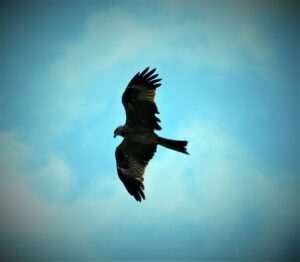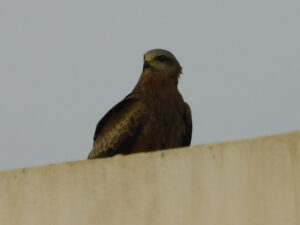Black Kite | Milvus migrans
Indian Bird – Black Kite:
Birds of prey are always a subject of interest for photographers. The Indian Black kite is one such bird that I always wanted to capture but it is extremely difficult for to as they are always
flying high in the sky. I use a point and shoot camera (Nikon B500 with 40X optical zoom) and it’s very hard to focus. Even if you use a tripod it’s very hard to take a shot/video when the bird is flying very
very high in the sky.
For some reason, I realize there are so many black kites hovering over my apartment. A couple decided to take some rest in the roof just opposite my balcony and I managed to capture a few shots and few videos. They look amazingly beautiful.

Kite in Flight

Black Kite Relaxing

In the rooftop
Facts:
The black kite is a medium-sized bird of prey in the family Accipitridae, which also includes many other diurnal raptors.
It is thought to be the world’s most abundant species of Accipitridae, although some populations have experienced dramatic declines or fluctuations.
Scientific name: Milvus migrans
Mass: 730 g
Length: 47 – 60 cm
Conservation status: Least Concern
Higher classification: Milvus
Phylum: Chordata
Black kites can be distinguished from red kites by the slightly smaller size, less forked tail (visible in flight), and generally dark plumage without any rufous.
The sexes are alike. The upper plumage is brown but the head and neck tend to be paler. The patch behind the eye appears darker.
The outer flight feathers are black and the feathers have dark crossbars and are mottled at the base. The lower parts of the body are pale brown, becoming lighter towards the chin.
The body feathers have dark shafts giving it a streaked appearance. The cere and gape are yellow, but the bill is black (unlike in the yellow-billed kite).
The legs are yellow and the claws are black. They have a distinctive shrill whistle followed by a rapid whinnying call.
Males and females have the same plumage but females are longer than males. Their wingspan is around 150 cm
Here is a small video.
If you haven’t seen a black kite on the ground then watch this video
You may also like to know of other birds of prey like Pelicans, Black Shouldered Kite
Reference: @Wikipedia


Best view i have ever seen !
I am glad that I discovered this website, precisely the right info that I was searching for!
Your logic should be taken as the standard when discussing this topic.
Hi nice website https://google.com
Thanks a bunch for sharing this with all people
you actually recognize what you’re speaking approximately!
Bookmarked. Please additionally discuss with my site =).
We could have a link change contract between us
Great content! Super high-quality! Keep it up! 🙂
Thank you so much!! Glad you like it!!!
Awesome post! Keep up the great work! 🙂
Thank you!!!